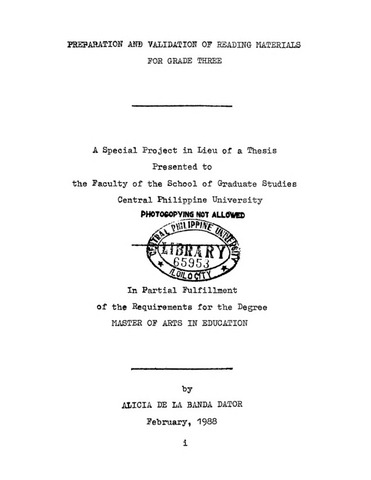Ipakita ang simpleng tala ng item
Preparation and validation of reading materials for grade three
| dc.contributor.author | Dator, Alicia D. | |
| dc.date.accessioned | 2021-06-10T05:34:00Z | |
| dc.date.available | 2021-06-10T05:34:00Z | |
| dc.date.issued | 1988 | |
| dc.identifier.citation | Dator, A. D. L. B. (1988). Preparation and validation of reading materials for grade three (Unpublished Master's thesis). Central Philippine University, Jaro, Iloilo City. | en_US |
| dc.identifier.uri | https://hdl.handle.net/20.500.12852/1008 | |
| dc.description | Abstract only | en_US |
| dc.description.abstract | This study was to prepare and validate six reading materials for grade three with emphasis on word recognition and comprehension skills. These materials were also made to serve as supplementary reading materials of the basal readers for grade three pupils of the District of Dingle, Division of Iloilo. Pupils' interests, the objectives of reading in grade three, and content area in which reading skills in English is used were considered in the preparation of the materials. Numbers were assigned to the selections instead of titles because one of the skills to be tested was choosing the best title for a selection. The first two, were stories for pure entertainment, the next two were transitional stories with Science or Mathematics content, and the last two were informational essays with Science content. The six reading selections were each accompanied by a ten-item test exercises to test the skills for getting word meanings, noting details, getting the main idea and choosing the title for a selection. A cloze test was also prepared to further test the readability of the reading selections. This study sought to answer the following questions: 1. What kind of stories are interesting to grade three pupils? 2. Are the materials prepared by the researcher readable? 3. Are the exercises developed to test the comprehension of the reading selections valid and reliable? A sample of fifty nine pupils chosen at random from one central school and three barrio schools in the District of Dingle, Iloilo, took the cloze test to determine the readability of the selections. Another sample of fifty nine pupils chosen at random from one central school and another three barrio schools in the District of Dingle, Iloilo, took the silent reading test. The data were taken from the six reading materials based on pupils’ interests and preferences together with the silent reading exercises, and the cloze test which were pre pared by the researcher. For evaluating the validity of the reading selections, appraisals of peers and reading experts were used, and for the test items, the index of difficulty and discriminative power of the test items were determined through item analysis. For determining the reliability of the test items, the Kuder-Richard Formula 20 was used. Findings showed that the materials were within the reading interests of the grade three pupils, with the result of the reading interest inventory being used by the researcher as basis in the preparation of the materials. All the six reading materials were readable as revealed by their length, vocabulary load, number of words and sentences, and as shown by the result of the cloze test where 82 per cent of the grade three pupils were in their independent reading level. The silent reading exercises that go with the selections were valid as indicated by the result of item analysis which showed that out of sixty items, fifty-three items were good, three items were poor and were eventually revised, and four items were marginal. These four marginal items were further validated through the use of the point biserial coefficient of correlation (rpbi). Three items showed acceptable power; One item was revised. Most of the reading exercises that accompanied the selections were reliable as indicated by their internal consistency of .56 to .70. The following recommendations were given: 1. The reading interest inventory used in this study be used by grade throe teachers to guide them in their choice of reading materials for the intended grade level. 2. The items in the test exercises which were found to be poor should be revised. 3. A word list for grades one to six be compiled for the use of the teachers preparing the materials for Western Visayas Schools. 4. For further research, the reading materials be tried out again under better conditions to get better index of their reliability. | en_US |
| dc.format.extent | ix, 179 leaves | en_US |
| dc.language.iso | en | en_US |
| dc.subject.ddc | GSL Theses 378.242 D262 | en_US |
| dc.subject.lcsh | Reading | en_US |
| dc.subject.lcsh | Reading (Elementary) | en_US |
| dc.subject.lcsh | Reading--Aids and devices | en_US |
| dc.subject.lcsh | Reading--Aids and devices--Evaluation | en_US |
| dc.title | Preparation and validation of reading materials for grade three | en_US |
| dc.type | Special paper | en_US |
| dc.description.bibliographicalreferences | Includes bibliographical references | en_US |
| dc.contributor.chair | Cang, Ma. Febe | |
| dc.contributor.committeemember | Grecia, Elsa | |
| dc.contributor.committeemember | Pahunao, Elnora | |
| dc.contributor.department | School of Graduate Studies | en_US |
| dc.description.degree | Master of Arts in Education | en_US |


